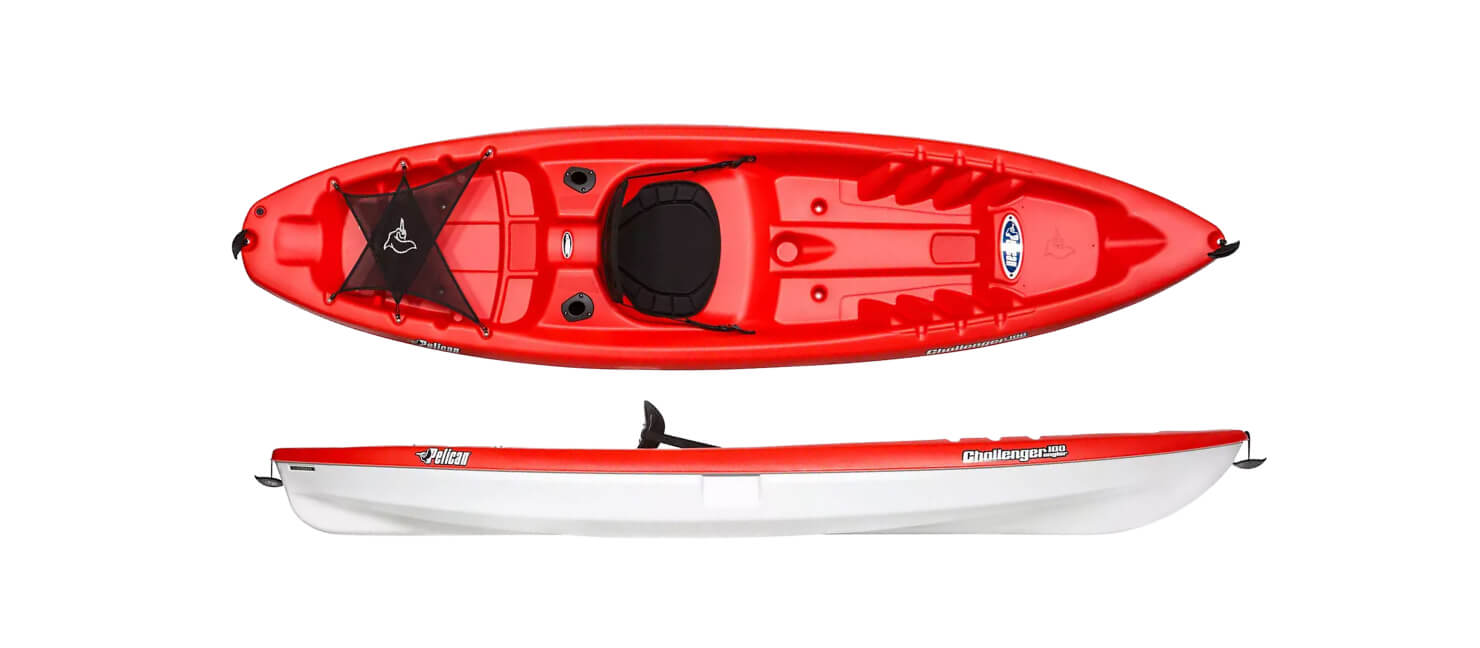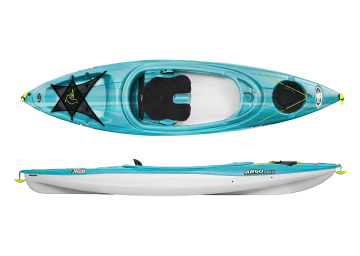A Guide to the Different Types of Kayaks

Whether you're gliding across calm lakes or exploring the open sea, there's a kayak designed to suit your style. But with so many different types of kayaks out there, it can be tricky to know where to start. In this blog, we’ll break down the following 16 types of kayaks and help you figure out which is best for your next paddling trip:
Key Takeaways
- Types of Kayak Categories — There are five categories kayaks are typically divided into: sit-on-top, sit-in (recreational), sit-in (touring), tandem, and inflatable.
- Other Types of Kayaks — Youth, hybrid (or crossover), and folding kayaks aren’t as common as those in the main categories, but they’re popular amongst young paddlers, those who plan to kayak for multiple reasons, and those who need a compact option.
- Types of Kayaks for Specific Activities — Discover different types of kayaks designed for specific water adventures.
Types of Kayak Categories
Although there are many types of kayaks to choose from, they all fall within five categories: sit-on-top, recreational use sit-in, touring use sit-in, and tandem. They are propelled through the water using paddles, but some are propelled by pedals. We’ve broken them down for you below.
| Main Types of Kayaks Chart | |||||
|---|---|---|---|---|---|
| Name | Image | Best For | Best Water Type | Hull Width + Length | Storage |
|
Sit-On-Top Kayaks |

|
Recreation |
Flatwater:
|
Wide | Shorter |
Limited |
|
Sit-In Kayaks (Recreational) |

|
Recreation |
Flatwater:
|
Wide | Shorter |
Limited |
|
Sit-In Kayaks (Touring) |

|
Touring |
Whitewater:
|
Narrow | Longer |
More |
|
Tandem Kayaks |

|
Recreation |
Flatwater
|
Wide | Longer |
Limited |
|
Inflatable Kayaks |

|
Recreation |
Flatwater:
|
Wide | Shorter |
Limited |
|
Fishing Kayaks |

|
Fishing |
Flatwater:
|
Wide | Shorter or Longer |
More |
1. Sit-on-Top Kayaks

Sit-on-top kayaks are one of the most popular types of kayaks. They are perfect for beginners and recreational kayaking because they are the easiest to maneuver. They have spacious cockpits that are ideal for sitting in for longer periods of time and have plenty of room for storing your gear.
Pros
|
Cons
|
Expert Tip:
If storage is your main concern, opt for a sit-on-top kayak with a wide hull.
2. Sit-in Kayaks

Paddlers sit inside sit-in kayaks. They are popular because they give paddlers more control. Because paddlers are less exposed to the elements in these kayaks, you’ll stay drier. You can attach spray skirts to them to avoid getting drenched. Because of this, sit-in kayaks are a great choice for year-round paddlers.
Pros
|
Cons
|
3. Tandem Kayaks

Tandem kayaks seat 2+ people in separate cockpits. The market offers tandem kayaks equipped to handle just about any adventure.
Pros
|
Cons
|
4. Inflatable Kayaks

If you're looking for a kayak that's easy to transport, an inflatable kayak is a great option. Made from durable materials that can withstand rigorous use, they can be easily deflated and packed away. Inflatable kayaks are stable on the water, ideal for anyone who wants a leisurely paddle on a budget.
Pros
|
Cons
|
Other Types of Kayaks
While the types of kayaks below aren’t one of the main categories of kayaks, they are popular choices for groups of paddlers.
5. Youth Kayaks

Youth kayaks are shorter, smaller, and lighter weight than other kayaks. Small kids and younger teens will find these easiest to paddle and maneuver. Most will be usable only in flatwater bodies and recreational conditions. Their key features include:
- Wider hulls for increased stability.
- Easy-to-use designs that focus on safety.
- Impact-resistant materials.
6. Hybrid or Crossover Kayaks

When you’re unable to purchase two separate types of kayaks, you need to find something that can adapt to most of your needs. That’s where hybrid kayaks shine! The fun with crossovers is there are endless possibilities with them. They can be solo or tandem, sit-in or sit-on-top, and can be used for leisure and specific activities, depending on the crossover you choose. Hybrid kayaks typically feature:
- Open, spacious cockpits.
- Stable, comfortable designs.
- Multiple storage areas.
7. Folding Kayaks

Folding kayaks are great for paddlers who need something lightweight and easy to transport. They’re designed to fold up compactly, making them perfect for people with limited storage space. Despite being collapsible, they’re sturdy and perform well in various water conditions. Their key features include:
- Quick and easy setup.
- Customizable accessories, such as spray skirts and rudders.
- Abrasion-resistant materials.
Types of Kayaks for Specific Activities
Looking for a kayak that meets the needs of a specific activity? Whether you’re an angler, photographer, or sea explorer, there’s a type of kayak out there for you.
8. Fishing Kayaks

Anglers who want to get closer to their desired catch use fishing kayaks. They’re usually outfitted (or can be later on) with attachments like rod holders and live wells. They come in various sizes and have wider hulls for storing fishing gear. Fishing kayaks are best suited for calmer waters like rivers and lakes. Their defining features include:
- Some have pedal-driven propulsion systems or small motors.
- Comfortable, adjustable seats.
- Some have built-in anchor systems or anchor trolley setups.
9. Day Touring Kayaks

Day touring kayaks give you the space, balance, and stability you need to explore comfortably. Choose a day touring kayak if you’re a remote hiker, photographer, or seeker of your next laid-back adventure. Their main features include:
- Typically longer and narrower than recreational kayaks.
- They often have a skeg or rudder to help with straight-line tracking.
- Watertight storage hatches for carrying gear.
10. Touring Kayaks

For adventurers who seek to chart undiscovered sights, touring kayaks are the best option. They offer a comfortable, efficient experience when paddling for extended trips in wilder whitewater bodies. Some of their defining features include:
- A larger cockpit area for long trips.
- Ample storage space for gear and supplies.
- A variety of attachment points for securing gear to the deck.
Expert Tip:
Always make sure you properly outfit your touring kayak with the necessary safety gear before heading out!
11. Recreational Kayaks

Recreational kayaks allow you to slow down on the water, get in some unique scenery, and exercise with friends or family! They are engineered with the beginner in mind, with shorter lengths and wider hulls that reduce the risk of capsizing. They can be bought or rented. Their main features include:
- Typically designed to be easy to enter and exit.
- They are usually slower but more stable.
- They are lightweight and easy to carry.
Expert Tip:
Most rental huts tend to offer sit-on-top kayaks because of how easy they are for beginners to paddle.
12. Photography Kayaks

Kayaking gives photographers the opportunity to capture the natural beauty of more remote and often undisturbed areas. To protect your equipment, look for a kayak built to give you the following so you never miss out on the perfect shot:
- The best stability possible.
- Plenty of storage.
- A comfy seat.
- A large cockpit.
Expert Tip:
Use waterproof cases and dry bags to protect your phone, important small cords, or your SD cards while you shoot.
13. Sea Kayaks

Sea kayaks can withstand rough whitewater coastal conditions. They have a distinct, sharp V-shaped bow (the front) that makes them perfect for unpredictable waters and waves. Sea kayaks have a variety of features, such as:
- A skeg or rudder that helps with tracking in windy or choppy conditions.
- Bulkheads and hatches that provide storage and buoyancy.
- Deck lines and other safety gear that help with rescue.
14. Surf Kayaks

Surf kayaks are ideal for maneuvering whitewater coastal waves. These are relatively easy to learn and use and provide a great workout. Most offer a variety of features that aid in a better surfing experience like:
- Skegs to help move the kayak straight forward.
- Sealed hatches to keep water out.
- Buoyancy tanks to help keep the kayak afloat in waves.
15. Diving Kayaks

Diving kayaks are specially fitted to allow divers to explore underwater caves and other difficult-to-reach or remote areas. They always prioritize storage space, so you’re never without the things you need most. They include features like:
- Storage compartments for dive equipment.
- Secure latching systems to keep the kayak stable underwater.
- Comfortable seating arrangements.
16. Whitewater Kayaks

Whitewater kayaks are built for whitewater and fast river currents. They are usually shorter and narrower than other types of kayaks, making them more maneuverable in tight spaces. Their flared sides help stabilize it in moving water, so there are safeguards that you can use to mitigate how much you capsize. They have features like:
- A rounded or more rockered hull.
- Impact-resistant materials.
- Snug-fitting cockpits for enhanced control.
Expert Tip:
Get the correct size kayak for your body type. Whitewater kayaks can be tricky to handle if they're too big or too small.
Have Fun Out There!
No matter what kind of water adventure you’re planning, there’s a kayak out there that’s perfect for you. If you’re ready to hit the water, check out the wide selection of kayaks and kayak accessories available at Academy Sports + Outdoors!


